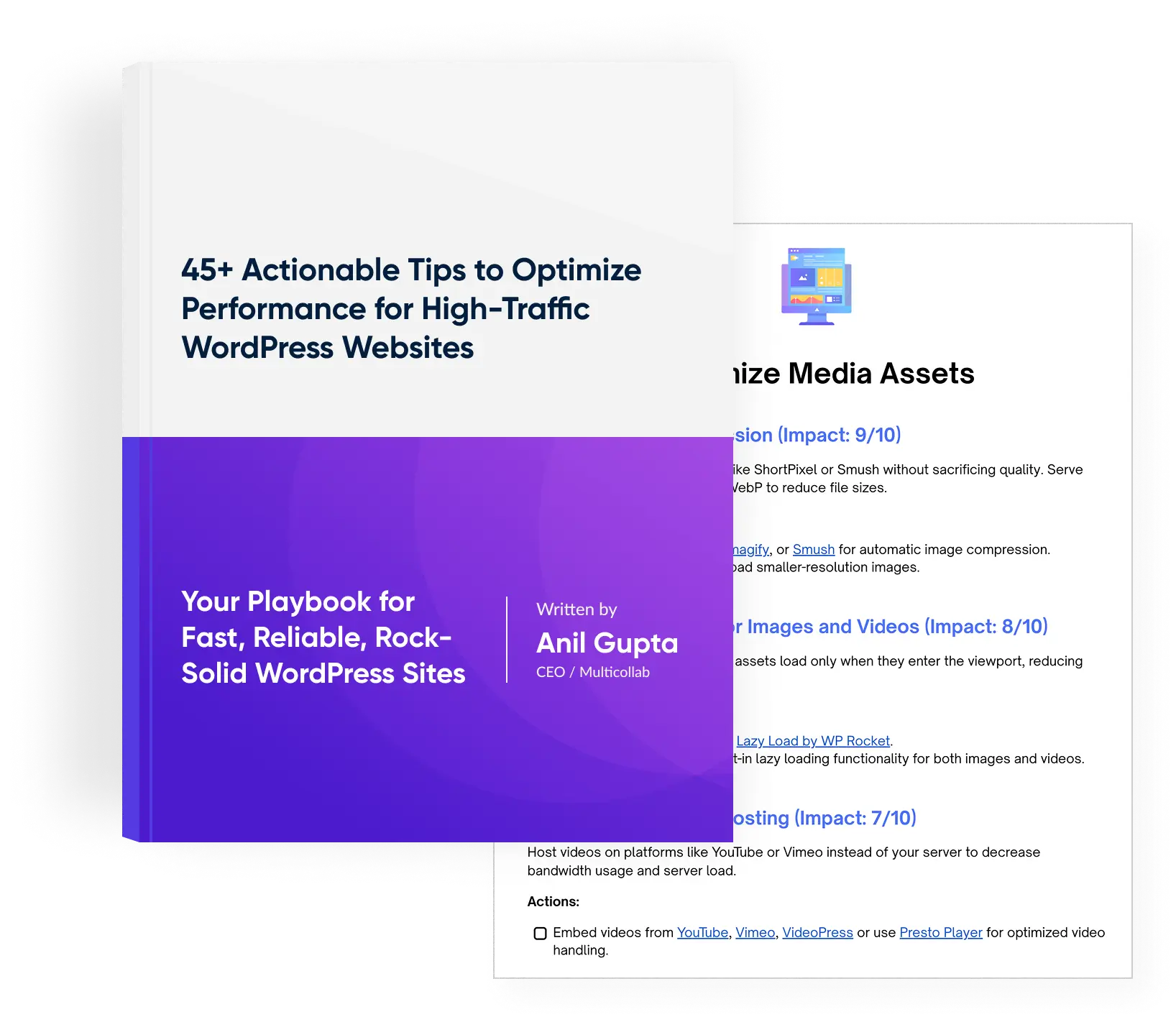Table of Contents
Businesses and organizations today are churning out tons of quality content at scale to connect with audiences, boost brand visibility, and stay ahead of the competition.
Take, for example, a popular environmental publication that noticed a growing interest in sustainability. They decided to shake things up by moving from a monthly to a weekly publishing schedule. They introduced in-depth articles, expert interviews, and even community spotlights. This strategic move is all about helping them attract more readers and increasing their subscriptions within the next few months.
But here’s the catch: with all that extra content production comes the challenge of keeping quality high while racing against tight deadlines. For content teams, finding that sweet spot between producing more and maintaining quality is crucial.
So, how do organizations tackle this challenge?
By adopting effective strategies and using smart tools designed to boost productivity without sacrificing quality. In this blog, we will explore practical methods and tools that help content teams scale their production effortlessly. We will also take a look at how collaboration tools like Multicollab can simplify the content approval process, helping teams stay agile and productive while being competitive.
Understanding high-volume content production
High-volume content production is all about consistently creating and publishing a large amount of content. This can include blog posts, social media updates, videos, podcasts-you name it! Industries like eCommerce, digital marketing, and media often require a constant flow of fresh content to keep customers engaged.
As teams ramp up their content output, they often face a few hurdles:
Managing Deadlines and Workloads: Juggling multiple projects and hitting deadlines can lead to burnout for content teams managing high-volume content production.
Ensuring Quality and Consistency: As the output increases, maintaining the same quality is vital to avoid damaging a brand’s reputation. Nobody wants to put out confusing or low-quality content!
Coordinating Multiple Contributors: Working with different writers, editors, and stakeholders can make communication tricky. Miscommunication can lead to inconsistent messaging, which only complicates matters.
How to scale content creation

Scaling your content creation doesn’t have to be overwhelming. With the right strategies in place, you can boost output and maintain consistency without sacrificing quality. Let’s dive into some effective ways to make it happen.
1. Developing a robust editorial calendar
An editorial calendar can serve as the backbone of your content strategy. By planning and scheduling content ahead of time, teams can manage workloads effectively and ensure a consistent publishing rhythm.
For example, if you’re a marketing team publishing two blog posts and five social media updates each week, tools like Trello, Asana, or Google Sheets can help organize tasks, assign deadlines, and keep everyone on track.
Scenario: An editorial team, consisting of writers, editors, and content managers, meets monthly to discuss upcoming trends, product launches, or newsworthy topics in the tech industry. They break down content needs into categories such as product reviews, tech news, how-tos, and opinion pieces.
Tools used: Monday.com for task assignments, Google Sheets for content calendar tracking.
Weekly goal: 30 articles (5 articles/day), 3 videos, 10 social media posts, and a weekly newsletter.
2. Batch content production
Batching involves grouping similar tasks together to enhance productivity. For instance, a content team might dedicate Monday to writing all blog posts for the week, Tuesday to designing accompanying visuals, and Wednesday to scheduling social media posts. This focused approach reduces time spent switching tasks and allows for deeper creative flow, making the entire content creation process smoother.
Scenario: One writer might work on five product review articles for the week, while another focuses on producing four how-to guides. Meanwhile, the video team shoots footage on set days, editing the content in a batch for weekly releases. Editors review articles in daily batches to keep the workflow moving.
Tools used: WordPress for drafting and managing articles, Grammarly for quick checks, and Trello for assigning batches of work to specific writers or editors.
Automation: Using tools like Buffer to schedule social media posts automatically and tools like Multicollab Wordable to draft content directly within the WordPress editor saves time and minimizes manual work.
3. Repurposing existing content
Repurposing involves taking existing content and adapting it for different formats or audiences. For example, an in-depth blog post on a trending topic can be repurposed into a series of LinkedIn posts, a video tutorial, or even a podcast episode. This strategy maximizes your content’s reach while saving time, as you’re working from existing material rather than starting from scratch.
Scenario: To maximize the value of each piece of content, the team repurposes each article into different formats. For example:
- A blog post titled “Top 10 Smartphones of 2024” becomes a short YouTube video with similar key points.
- The same article is then transformed into a series of Instagram posts highlighting each smartphone.
- The main points are summarized and featured in the weekly newsletter.
4. Establishing clear workflows
Having defined processes for content creation, review, and approval is essential for maintaining efficiency. For example, using project management tools like Monday.com or ClickUp can ensure that every step—from drafting to publishing—is streamlined, with clear deadlines and assigned responsibilities. This way, everyone knows who is handling what, which reduces bottlenecks and speeds up the overall workflow.
Scenario: With a large amount of content being produced weekly, clear workflows are essential. The publication has established a transparent workflow for content production:
Step 1: Writers draft the articles within the WordPress editor using Multicollab plugin and mention the editors to get the review started.
Step 2: Editors review and provide feedback through inline comments and @mentions in Multicollab, ensuring any revisions are made quickly.
Step 3: Once approved, the articles are sent to the design team to add custom images for social media or the website.
Step 4: The content is then uploaded, optimized for SEO, and scheduled for publishing using WordPress.
To keep communication smooth, they use Slack for quick updates and discussions about any pressing issues or urgent changes. This ensures that everyone—from writers to video editors to social media managers—knows what’s expected of them.
5. Leveraging automation & AI tools
Given the scale, automation and AI tools are crucial in a high-volume content production environment. For instance:
Content tracking: An analytics tool like Google Analytics or Ahrefs is set up to track how each article performs, allowing the team to pivot or refine content based on audience engagement.
AI-based content tools: They use Jasper.ai to generate first drafts of product descriptions or SEO-friendly snippets.
Automated scheduling: All social media posts are scheduled in bulk using Buffer or Hootsuite, saving the team hours of manual work each week.
6. Scalability through freelance support
To handle this high volume, the publication can outsource part of the work to freelancers. While the core team handles critical or time-sensitive content, they can rely on trusted freelancers to produce background stories, listicles, or feature articles. A content manager can assign and review the work to ensure quality control before integrating it into the regular publishing workflow.
The publication uses platforms like Upwork for hiring freelancers and managing contracts, payment schedules, and project deadlines.
7. Monitoring & optimization
The success of such high-volume production relies on constant monitoring. Weekly editorial meetings are held to review analytics, assess which articles or content formats are performing best, and make adjustments. Content audits every quarter help them refine the strategy, ensuring that the publication isn’t just churning out content but delivering value that resonates with their audience.
Tools used: Ahrefs and SEMrush for keyword tracking, Google Analytics for audience engagement, and Hotjar for understanding user behavior on the website.
How to scale content creation with tools like Multicollab
Multicollab is a powerful collaboration tool designed specifically for WordPress content teams. Its features enhance the content creation process, making it easier to manage high volumes of content output. Lets take a look at its core features that can help you scale content production.
Real-time collaboration
One of Multicollab’s standout features is real-time collaboration, allowing multiple users to edit content simultaneously. Team members can work together on the same post, making instant changes and seeing the content come to life right in the WordPress interface. This efficiency saves time and fosters a collaborative atmosphere.
Inline comments for feedback
With Multicollab, users can add inline comments on any text or media during the drafting and editing phases. This feature simplifies the feedback process, enabling team members to provide context-specific insights directly within the document. Commenting becomes as seamless as in platforms like Google Docs, promoting open communication.
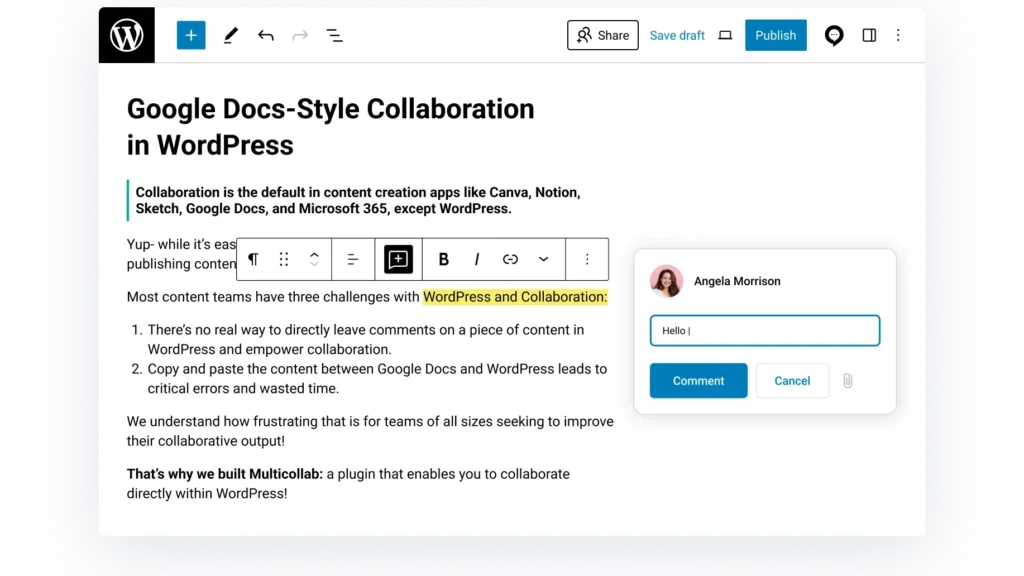
Team collaboration features
Multicollab encourages team collaboration with features like mentions and email notifications. When a team member needs input, they can mention colleagues, who will receive instant email alerts. This ensures quick responses and keeps the project moving forward.
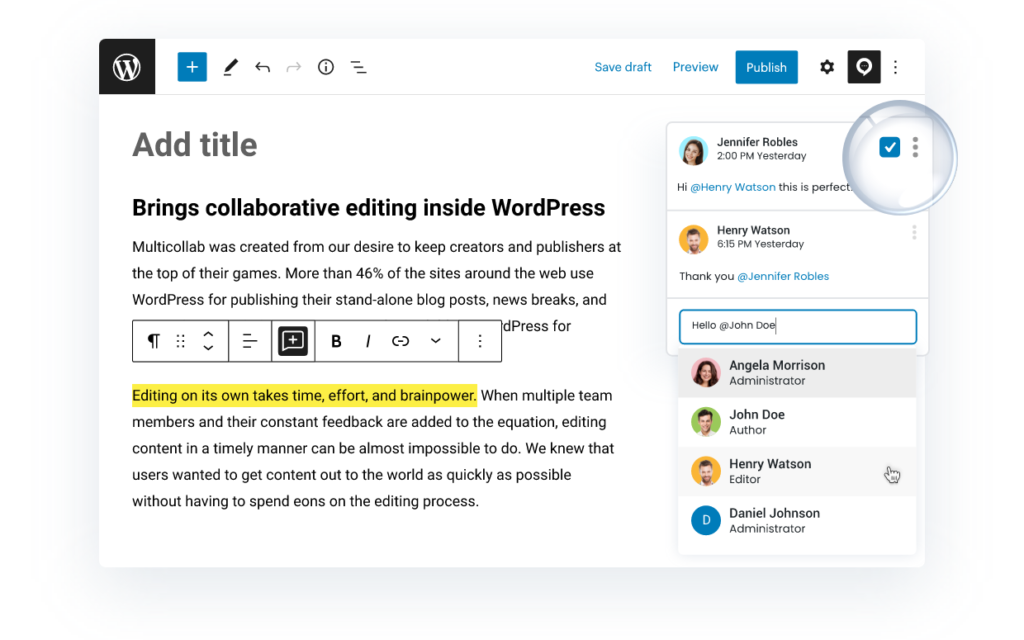
Guest collaboration options
Another valuable aspect of Multicollab is its guest collaboration feature. Stakeholders such as clients or external editors can be invited to review content without needing a WordPress user account. You can assign roles like Commenter or Viewer, allowing guests to provide feedback while maintaining control over the editing process.
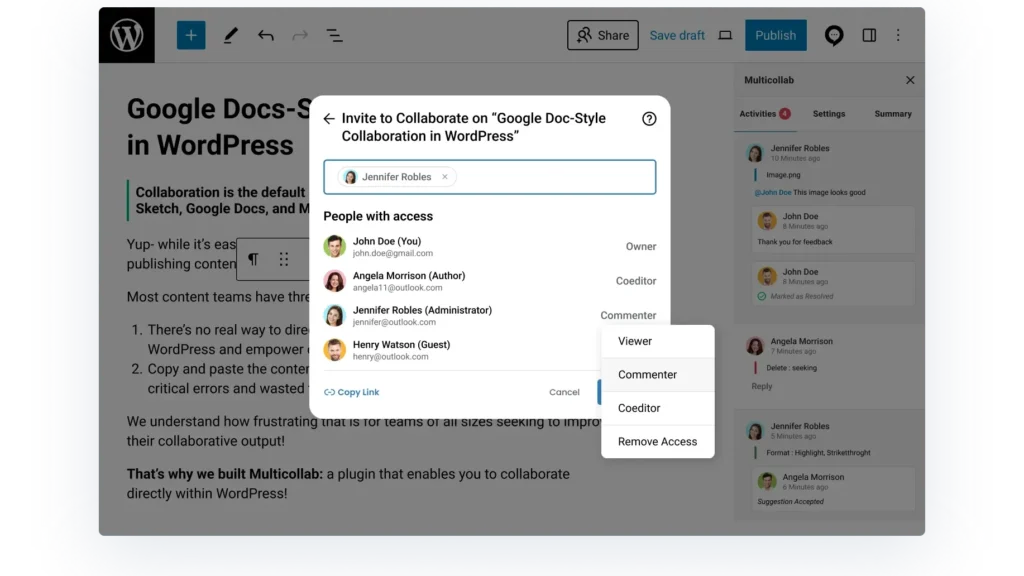
Activity reports and insights
Multicollab’s Advanced Dashboard provides teams with vital insights into their editorial workflows. Activity reports help monitor collaboration efforts, track progress on content pieces, and ensure accountability among team members.
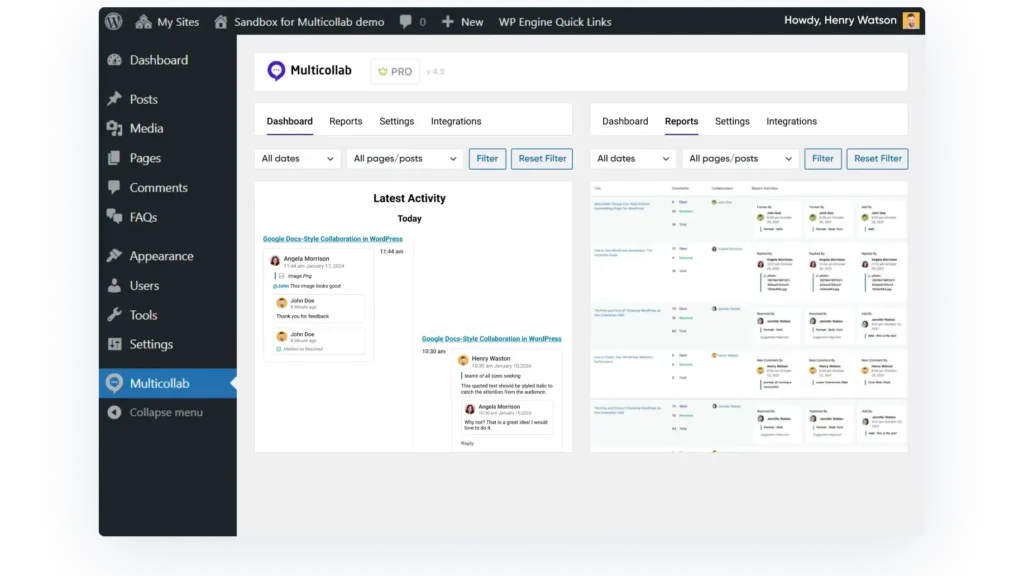
Custom permissions for better management
The ability to set custom permissions is another feature that strengthens the management of content. Team leaders can decide who can manage comments and suggestions, creating a tailored approach that enhances security and workflow.
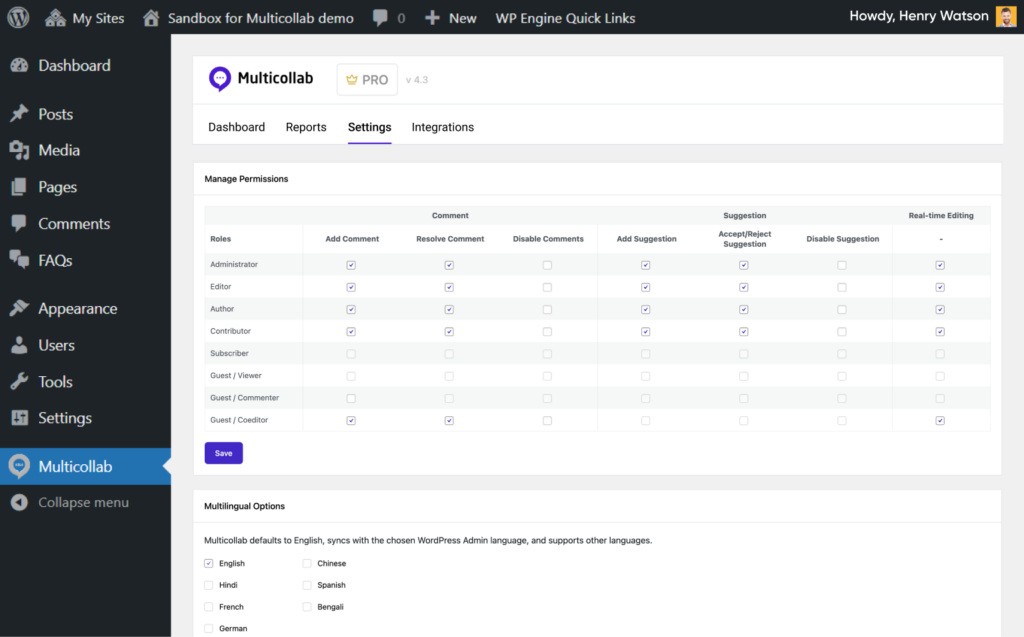
Multilingual support for diverse teams
Multicollab also offers multilingual support, making it accessible for teams that operate in these six languages: German, Chinese, Hindi, Spanish, French, and Bengali. All elements, including comment boards and settings, will automatically sync to the selected language, allowing for seamless collaboration in the user’s native language.
Conclusion
To stay competitive, managing a high volume of content production is essential.
With the right strategies and tools in place, editorial teams can effectively overcome challenges and streamline their workflow. A structured approach that incorporates features like real-time collaboration and advanced project management can transform how your team creates, reviews, and publishes content.
So, if you’re looking to scale your content creation efforts and take your editorial processes to the next level, consider implementing Multicollab to empower your team and elevate your content strategy. The future of content creation is collaborative; let Multicollab be your partner in this journey.



